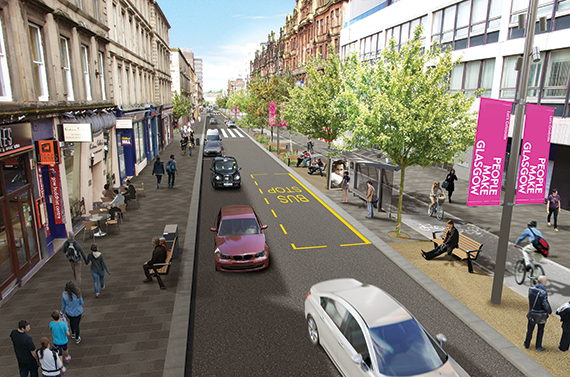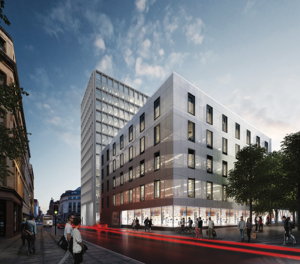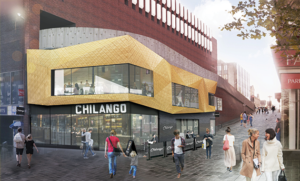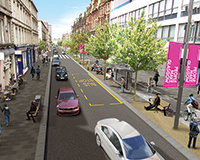 In its heyday, Sauchiehall Street was a thriving retail thoroughfare. Yet as Glasgow’s retail pitch has evolved and focused on the adjoining prime pitch of Buchanan Street, Sauchiehall Street has suffered a steady demise, characterised by tatty buildings, a neglected streetscape and low-value occupiers.
In its heyday, Sauchiehall Street was a thriving retail thoroughfare. Yet as Glasgow’s retail pitch has evolved and focused on the adjoining prime pitch of Buchanan Street, Sauchiehall Street has suffered a steady demise, characterised by tatty buildings, a neglected streetscape and low-value occupiers.
The council now wants to redress the balance through a new regeneration project aiming to make Sauchiehall Street more appealing through improved public realm, accessibility and a greater focus on non-retail uses.
Launched in May, the regeneration framework for Sauchiehall Street and Garnethill outlines a 10-year plan to boost visitor numbers. It incorporates eight key projects, from making the area more cycle- and pedestrian-friendly to creating a roof garden over the M8.
“Planners haven’t adapted to the changes in the way we shop. Right now the policy is so restrictive”
Feasibility work will be carried out over the next 18 months to two years on the framework’s key projects, which councillors will then have the option of funding via Glasgow’s £115m City Deal.
In the meantime, £5m is being spent on Sauchiehall Street Avenue, a project to improve the non-pedestrianised section by widening pavements, tree planting, cycle facilities and street seating.
Agents welcome the council’s intervention. Craig Wallace, JLL’s director of planning and development in Scotland, says: “Something has to change. In recent times there has been a real decline in both the quality of the street’s environment as well as its tenants.”

Yet it will take more than a streetscape makeover to reverse Sauchiehall’s fortunes. The real challenge will be finding a new identity for a street that will never again be Glasgow’s premier retail destination.
Cushman & Wakefield partner John Menzies says: “What is really needed is a much more vibrant mix of uses. Unfortunately Glasgow is really suffering from outdated planning policy. If you want to use a class 1 (A1) retail unit for anything other than retail you have to apply for a change of use.”
Although some landlords have managed to persuade the planners to give vacant retail units consent for change of use (see Sauchiehall Building panel below), it is rare.
Agents say Sauchiehall Street has attracted strong interest from leisure operators. The west end of the street has already established itself as an entertainment district targeting the student market, yet there is growing demand to extend the leisure offer further east.
It has proved difficult to accommodate demand within the constraints of planning policy. For instance, London fast food brand Leon hoped to open its first Glasgow operation on Sauchiehall Street during the summer but had to abandon its plans due to a conflict with city planners over the balance of hot and cold food.
Mackay Planning’s Scott Mackay says: “Planners haven’t adapted to the changes in the way we shop. Right now the policy is so restrictive, meaning that even if a retail unit is void for more than a year there is no flexibility to allow landlords to explore alternatives.”
Local planning consultants hope that the new Local Development Plan (Glasgow City Part 3), which is expected to be adopted next spring, will allow for a greater range of uses and that supplementary guidance can help those areas covered by regeneration frameworks adapt to a changing retail landscape.
The council is exploring opportunities beyond retail through initiatives such as a review of the area’s evening economy and the development of a new city centre residential strategy. Likewise, the private sector is using its imagination in finding new uses for old buildings.
Examples include the planned redevelopment of the much-loved Willow Tea Rooms into a new tourist attraction and Formal Investments’ proposals to transform the BHS building on Sauchiehall Street into a £75m office and retail scheme. The development will incorporate a 130,000 sq ft 12-storey new-build office block and remodelled retail space.
“We considered all sorts of different uses for the building and how we might reposition it,” says Formal Investments managing director Nicholas King. “The street enjoys huge footfall, but the challenge is to change that through-flow into paying customers.”
King believes the site’s location and nearby amenities will appeal to office occupiers in a city that has a limited supply of grade-A space. He is also talking to two potential retail tenants for the former BHS space.
He is confident that Sauchiehall Street can still attract retailers, saying potential occupiers will be attracted not only to the street’s footfall, but by the prospect of a fall in business rates and the delay to the long-awaited expansion of the neighbouring Buchanan Galleries.
In July 2015 Land Securities announced it had put the brakes on its planned £400m expansion to its Buchanan Galleries shopping centre, blaming complications arising from the simultaneous delivery of a rail project running directly beneath the centre.
Local retail agents question whether the 392,000 sq ft redevelopment will ever happen. Whether it has been scrapped or merely delayed, Sauchiehall Street has, at least temporarily, been granted a reprieve. It also means that one of the street’s anchor retailers, M&S, which was due to decamp to the extension, will for now be staying put.
Savills retail director Estelle Forrester argues that with some masterplanning, the street still has a future as a retail destination. She says: “Its diverse ownership is a challenge but if landlords are prepared to invest and reconfigure units, I think there is real opportunity for it to become the prime secondary pitch.”
Forrester says that off a peak of around £160 per sq ft pre-recession, headline zone-A rents have now been rebased at around £110, evidenced by recent deals such as stationery chain Rymans’ commitment to take 2,500 sq ft at 42 Sauchiehall Street.
Although agents predict the bulk of future retail demand for the street is likely to come from branded discount and value retailers, Sauchiehall can offer an alternative to retailers who are struggling to secure units on Buchanan Street.
Forrester says: “The problem with the retail pitch contracting is that there is quite a backlog of requirements. Buchanan Street isn’t big enough to accommodate everyone and unless there is a future for retail on Sauchiehall Street, we run the risk of becoming a one-trick pony.”

Sauchiehall Building’s new lease of life
The transformation of the Sauchiehall Building into a vibrant mixed-use asset proves what can be achieved by combining an ambitious landlord with a commonsense approach by city planners.
Private equity firm Kohlberg Kravis Roberts (KKR) and asset manager Quadrant Estates acquired the Sauchiehall Building in 2015 and have succeeded in obtaining Class 3 consent to secure major lettings to US burger chain Smashburger and Mexican burrito chain Chilango.
The restaurants will sit in the two corner units and help reinvigorate a building that had lost occupiers such as Clinton Cards and JJB Sports.
The building is already home to retailers such as Primark and TK Maxx and its refurbishment has helped secure new lettings, including a 10,000 sq ft basement unit for Sports Direct. Lease extensions have also been agreed with WH Smith and Pure Gym.
Marketing will soon begin on the building’s final 4,500 sq ft leisure unit and there is potential to extend by a couple of floors, possibly to accommodate residential units.
Vanessa Buchan, associate partner at Quadrant Estates, says: “Leisure brands are drawn to Sauchiehall Street and its footfall of around 17m people. We demonstrated to the planners that we had failed to let the corner units and were willing to commit £2m of investment.”











